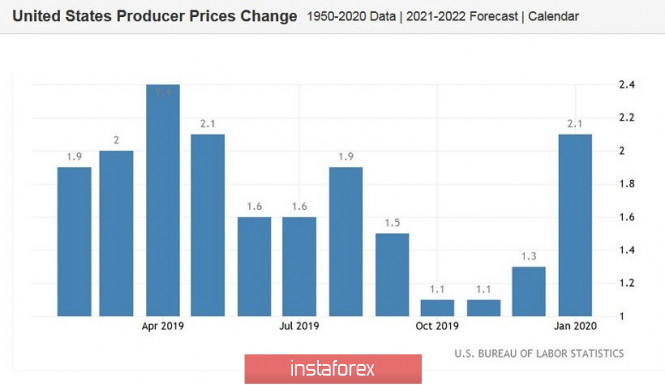The minutes of the January meeting of the US Federal Reserve turned out to be "passing": almost all theses were already voiced by Jerome Powell, including last week, when he delivered a half-year report to the US Congress. The market expectedly ignored the publication of this document - it did not help the bears of the euro-dollar pair gain a foothold in the seventh figure. Moreover, some remarks of the minutes brought up the concern of traders, so yesterday's battle ended in a victory for the bulls - unless, of course, the daily closing within the eighth figure can be called a victory.
Despite the general dullness and predictability of the Fed minutes, some points deserve special attention. During the January meeting, some regulator members expressed concern that low interest rates could contribute to "the vulnerability of the financial system." A number of their colleagues took the opposite position - in their opinion, "under certain circumstances, low interest rates can help maintain financial stability." Furthermore, the text of the minutes contains the phrase that "many participants noted the absence of a correlation between the influence of monetary policy and the vulnerability of the financial system, as a result of which the regulator decided to rely on inflation and employment indicators to determine future interest rates."

It should be noted here that, unfortunately, the minutes does not indicate many circumstances that would make it possible to understand the alignment of forces in the Fed. For example, we do not know exactly how many members of the Committee supported this or that opinion, or the initiative. Therefore, market participants have to draw independent conclusions based on the designations that the Fed operates with. In this case, "some" Fed members and "a number of their colleagues" expressed diametrically opposite positions regarding the efficiency (feasibility) of low interest rates. Nevertheless, "many participants" agreed in the end that it is impossible to speak with confidence about the relationship between the current monetary policy and the vulnerability of the financial system. It can be assumed that such a conclusion was reached by most of the participants in the meeting.
The very fact of such a discussion suggests that representatives of the dove wing of the Fed continue to advocate for easing the parameters of monetary policy. Although it is obvious that they are now in the minority, especially against the backdrop of recent macroeconomic data. Fed economists raised forecasts for US GDP growth in 2020 and 2021 (against the background of the first phase of a trade agreement with China), and also positively assessed the growth prospects of the US labor market. Coronavirus was recognized as a new risk for the prospects for the global economy, but Jerome Powell subsequently smoothed corners, saying that it was too early to draw certain conclusions in this context. He added that the epidemic will obviously affect the Chinese economy (especially in the first quarter of this year), however, it's premature to discuss the consequences for the world economy today.
In other words, the Fed minutes published yesterday made it clear that the regulator is ready to continue to maintain monetary policy in its original form. This conclusion was absolutely expected by the market, so traders ignored yesterday's release. Nevertheless, judging by the above dialogue between the regulator's members, we can conclude that some Fed members are still in favor of lowering the rate - and if inflation and the labor market indicators slow down, this issue will again be on the agenda. Such prospects do not bother dollar bulls yet. Recent Nonfarm and inflation indicators have supported the US currency. Other macroeconomic reports also allow the dollar to feel confident in almost all pairs.
For example, the US producer price index significantly exceeded forecast expectations yesterday. In annual terms, this indicator reached 2.1% - the strongest result since April last year. In monthly terms, it also reached many-month highs, rising to 0.6%. Excluding food and energy prices, the index also increased significantly: in annual terms, the indicator consistently decreased over the course of four months, but yesterday it jumped to 5-month highs. It should be noted that this index is an early signal of changes in inflationary trends; therefore, its growth helped strengthen dollar bulls throughout the market.

Today, the EUR/USD bears are still recording in the range of 1.0780-1.0810. The seventh figure is a serious test for the sellers of the pair, therefore, for the final consolidation in this price area, an appropriate news occasion is needed. For example, the minutes of the last ECB meeting will be published today - we will find out the details of the regulator's report from the meeting on monetary policy, which took place almost four weeks ago. But this document is unlikely to have a strong impact on the pair. Christine Lagarde made it clear enough that the regulator does not intend to change its monetary policy in the near future, while she expressed concern about the slowdown in inflation and industrial production. I believe that the minutes will reflect her opinion, only in a more expanded form.
The Fed-Philadelphia manufacturing index will be published today during the US session. This is a very minor indicator, however, against the background of an increase in the ISM manufacturing index, as well as the Empire Manufacturing manufacturing index, it can still affect the pair. Especially if it comes out better than forecasted values (according to forecasts, the indicator is expected to decline from 17 to 10 points).
The material has been provided by InstaForex Company - www.instaforex.com